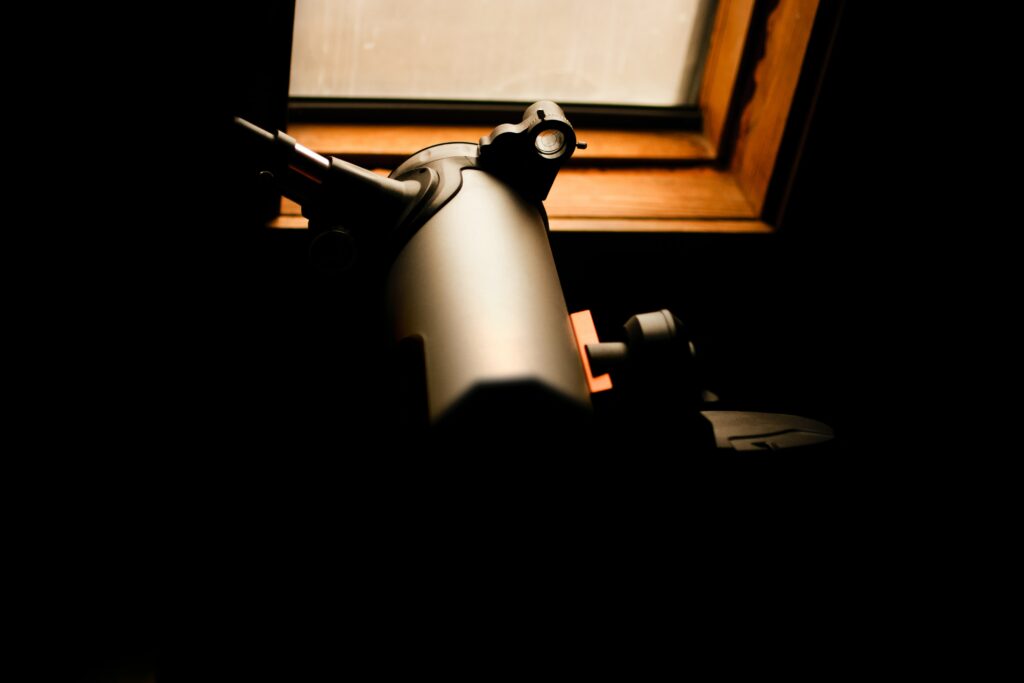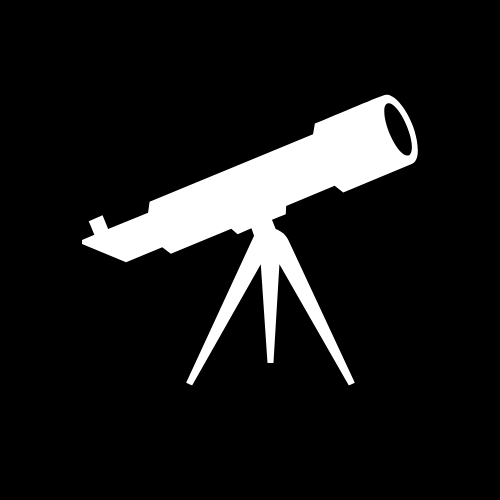Storage and maintenance of a telescope 101
Telescopes are vital tools in the world of astronomy, providing a means to observe and study the celestial objects in our universe. Whether it’s for professional use or personal enjoyment, telescopes require proper storage and maintenance to ensure optimal performance and longevity.

Cleaning
Regular cleaning of the telescope is important to keep it free from dust, debris, and fingerprints. Use a soft, dry cloth to wipe down the lenses and mirrors, and avoid using water, as it can cause damage. Before storing your telescope, it is important to clean it thoroughly to remove any dirt, dust, or fingerprints that may have accumulated during use. This helps to protect the delicate lenses and mirrors from scratches or damage and also ensures that your telescope will be ready for use the next time you want to observe the night sky.
Protect from the elements
Store your telescope in a dry, protected area to prevent moisture and other elements from causing damage. This can include storing it in a carrying case, a telescope storage container, or a climate-controlled room. Exposure to moisture, dust, and extreme temperatures can cause damage to your telescope’s lenses, mirrors, and electronics. If you do not have access to a dry indoor storage space, consider investing in a waterproof cover or a protective carrying case.
Avoid extreme temperatures
Exposure to extreme temperatures can cause damage to the telescope’s materials and components. Store your telescope in a place that is protected from extreme temperatures, such as a garage or attic, and avoid exposing it to direct sunlight.
Protect the lenses
The lenses on your telescope are some of its most sensitive components, and they need to be protected from scratches, dust, and other debris. Consider using lens caps or covers when not in use, and use lens cleaning solution or a soft cloth to clean them.
Store the tripod
When not in use, the tripod should be stored in a safe, secure place. Avoid stacking heavy objects on top of it, as this can cause damage to the legs.
Lubricate moving parts
Regularly lubricating the moving parts of your telescope can help to prevent wear and tear. Use a high-quality lubricant, such as silicone grease, on any moving parts, including the focuser, altitude and azimuth adjustments, and drive system.
Check for loose parts
Regularly inspect the telescope for loose or missing parts, and tighten any loose screws or bolts. If you notice any missing parts, replace them as soon as possible.
Avoid rough handling
When transporting or using your telescope, avoid rough handling, as this can cause damage to the instrument. Use a sturdy carrying case or a protective cover to prevent bumps and scratches.
Keep it dry
Avoid exposing your telescope to moisture, as this can cause rust and corrosion. If you must use the telescope in damp conditions, be sure to dry it thoroughly after use.
Store the eyepieces
Eyepieces should be stored separately from the telescope to prevent them from being damaged or lost. Consider using eyepiece cases or containers to keep them organized and protected.
Store the finder scope
The finder scope should be stored in a safe place, separate from the telescope, to prevent it from being damaged or lost. Consider using a finder scope case or container to keep it protected.
Align the finder scope
Regularly align the finder scope with the main telescope, as this will help you to accurately locate objects in the night sky.
Check the collimation
The collimation of the telescope refers to the alignment of its mirrors and lenses. Regularly check the collimation of your telescope to ensure that it is properly aligned, and make any necessary adjustments.
Check the drive system
The drive system of your telescope is responsible for tracking celestial objects. Regularly inspect the drive system to ensure that it is functioning properly and make any necessary repairs or adjustments.
Keep the telescope cover on
When not in use, be sure to keep the telescope cover on to protect it from dust and debris. Consider using a custom-fit cover that is specifically designed for your telescope model.
Use a dehumidifier
If you live in a humid climate, consider using a dehumidifier in the room where your telescope is stored. High levels of humidity can cause moisture to condense on the lenses and mirrors, which can lead to corrosion and other damage
Store the battery separately
If your telescope has a motor drive system that uses batteries, be sure to store the batteries separately from the telescope to prevent corrosion. Consider using a battery storage case or container to keep the batteries organized and protected.
Check the cables
Regularly inspect the power and control cables of your telescope to ensure that they are functioning properly and that there are no frayed wires or other signs of damage. If you notice any issues, replace the cables as soon as possible.
Store the controller
If your telescope has a computerized controller, be sure to store it separately from the telescope to prevent damage. Consider using a controller case or container to keep it organized and protected.
Seek professional maintenance
If you notice any issues with your telescope, or if you are unsure about how to properly maintain it, seek the assistance of a professional. An experienced astronomer or telescope repair specialist can help you to diagnose and repair any problems with your instrument.
| Aspect | Key Points | Additional Notes |
|---|---|---|
| Cleaning | Use soft, lint-free cloths and appropriate cleaning solutions | Avoid harsh chemicals |
| Storage | Store in a dry, temperature-controlled environment | Use protective covers |
| Handling | Careful transportation and assembly | Avoid dropping or jarring |
| Regular Checks | Inspect for loose parts and alignment issues | Adjust and tighten as needed |
| Environmental Protection | Protect from dust, moisture, and direct sunlight | Use desiccants if necessary |
| Accessory Care | Store eyepieces and other accessories separately | Clean regularly |
| Usage | Handle with care during observation | Avoid touching optical surfaces |
Follow the manufacturer’s guidelines
It’s also essential to follow the manufacturer’s guidelines for proper maintenance and storage of the telescope. Every telescope is different, and manufacturers may have specific recommendations for storage and maintenance based on their design and components. By following the manufacturer’s guidelines, you can ensure that your telescope remains in optimal condition for years to come.
A commercial telescope is a valuable investment that requires proper storage and maintenance to ensure optimal performance and longevity. Regular cleaning and inspection of the optics and mechanical components, following the manufacturer’s guidelines for maintenance and storage, and taking precautions when using the telescope are all essential to keeping it in top condition. By properly caring for your commercial telescope, you can enjoy its capabilities for years to come and get the most out of your investment.
Conclusion
In the realm of astronomy, the telescope is not just an instrument but a gateway to the cosmos. Its proper storage and maintenance, as we have explored, are pivotal to both its longevity and the quality of observations it can provide. By adhering to the guidelines of regular cleaning, careful storage, and attentive maintenance, astronomers can ensure their telescopes remain in peak condition, ready to reveal the wonders of the night sky.
Understanding the delicate balance between use and preservation is key. Regularly cleaning optical surfaces gently, protecting the telescope from the elements, and storing it in a stable, controlled environment safeguard it from common issues that could degrade its performance. Moreover, the meticulous care of accessories, such as eyepieces and mounts, is equally important to maintain the overall functionality of the setup.
The journey of an astronomer is one of patience and precision, qualities that are mirrored in the way we care for our equipment. The art of telescope maintenance is, in many ways, as intricate and rewarding as the art of stargazing itself. Each careful adjustment, each thoughtful cleaning, and each choice of storage is a step towards ensuring that every celestial observation is as clear and awe-inspiring as possible.
Thus, let us treat our telescopes not just as tools, but as cherished companions in our quest to unravel the mysteries of the universe. With proper care and regular maintenance, they will serve us faithfully, night after star-filled night, opening our eyes to the infinite beauty of the cosmos.
FAQ
Q: How often should I clean my telescope?
A: Regular cleaning is recommended, but the frequency depends on usage and environment. Monthly checks are a good practice.
Q: What cleaning solution should I use for the lens?
A: Use a mild, non-abrasive cleaning solution specifically designed for optical surfaces.
Q: Can I store my telescope in my garage?
A: Only if it’s dry and temperature-controlled. Extreme temperatures and moisture can damage the telescope.
Q: Should I disassemble my telescope for storage?
A: It’s not necessary to fully disassemble it, but separating some components can make storage easier and safer.
Q: How do I protect my telescope from dust?
A: Use a dust cover when the telescope is not in use and store it in a clean area.
Q: Is it okay to leave the telescope set up in my backyard?
A: Prolonged exposure to the elements is not recommended. Store it indoors when not in use.
Q: How do I know if my telescope needs re-collimation?
A: Regular checks are important. If images are not sharp or if the telescope has been jostled, re-collimation might be necessary.
Q: Can touching the lens damage it?
A: Yes, oils and dirt from fingers can damage the coating on the lens. Avoid touching optical surfaces.
Q: What is the best way to transport my telescope?
A: Use a padded case or original packaging to ensure it’s well-protected during transportation.
Q: Do I need to lubricate any parts of my telescope?
A: Yes, the moving mechanical parts may require occasional lubrication. Consult the manufacturer’s guide for specific instructions.
